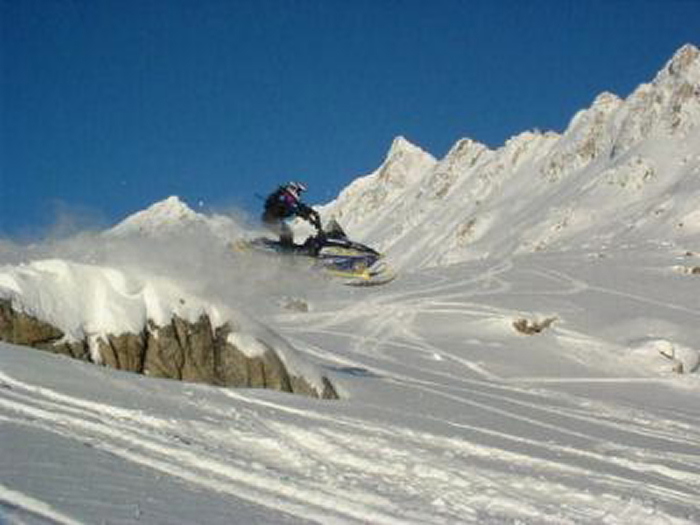Skagway Summit
One of the top destinations for Yukon snowmobilers, the Skagway Summit area is located just a couple short hours south of Whitehorse, and is accessible year-round via the paved and plowed South Klondike Highway. The Skagway Summit area provides many kilometers of varying mountain terrain and almost endless fresh powder to play in. However, as with any other riding area, it’s not without its dangers and challenges.
Visitors should be prepared for very limited signage and no services at the Skagway Summit. Avalanche gear and training is a must-have for snowmobiling at the Summit.
Also it is recommended to check current road conditions before going, as extreme conditions are possible and the South Klondike Highway sees frequent temporary closures as a result.
Important COVID-19 Information for the Chilkoot Trail National Historic Site:
After several months of being closed due to COVID-19, Parks Canada re-opened the Chilkoot Trail National Historic Site for winter activities on 15 December 2020. Snowmobilers are now welcome to use the area, however there are some additional restrictions and considerations. For more information please visit the Parks Canada website at https://www.pc.gc.ca/en/lhn-nhs/yt/chilkoot.
Snowmobiling At The Summit
In an effort to reduce environmental impact and help motorized users and non-motorized users share the area effectively, Parks Canada has come up with a Winter Recreation Strategy for the Chilkoot Trail National Historic Site, which covers a large portion of the Skagway Summit riding area. Included in this strategy is an annual Winter Use Schedule, which designates every third weekend throughout the winter season as “non-motorized only”. The schedule for the upcoming winter is made available each fall, and is posted on both the Parks Canada website and the Klondike Snowmobile Association’s Events page. To maintain the spirit of sharing the schedule is usually adjusted so the Buckwheat Classic Ski Race falls on a non-motorized only weekend, and in return spring break includes a multi-use weekend. More information on the Winter Recreation Strategy can be found on the Parks Canada Website at https://www.pc.gc.ca/en/lhn-nhs/yt/chilkoot/activ/hiver-winter.
Another consideration for snowmobiling at the summit is registration and insurance for your snowmobile. The Yukon Territory does not require registration or insurance for snowmobiles that are solely operated in the backcountry, but British Columbia does and most of the riding areas in the Skagway summit are in British Columbia. The R.C.M.P. does occasionally check for this, especially around popular weekends such as March break and easter.
Additionally, Recreation Sites and Trails BC has recently asked the Klondike Snowmobile Association to share a message kindly asking snowmobilers to please be aware of groomed cross country ski trails in the Log Cabin area…
“The Log Cabin Ski Trails are established as Recreation Trails under the Forest and Range Practices of B.C. with the intent and purpose of non-motorized recreational activities only, unless authorized. The trails are managed and maintained by local volunteers under a Partnership Agreement between the Log Cabin Ski Society and Recreation Sites and Trails B.C.
If you have any questions or require further information on the Log Cabin Ski Trail system please contact the Recreation Sites and Trails Branch office in Terrace, British Columbia at: 250-638-5100 or at RecInfo@gov.bc.ca .”

Additional considerations and advice:
- Be respectful of others – Snowmobiles can present a danger to other visitors, especially backcountry skiers and snowboarders. Please share the area respectfully.
- Slow it down – Maintain speeds that are responsible and practical for the conditions, especially at night or in flat light.
- Spread the word – The Klondike Snowmobile Association urges you to make sure your fellow snowmobile enthusiasts are aware of responsible and appropriate snowmobile use at the summit.
- Always ride sober – Snowmobiling in the mountains can be great fun, but requires full attention and quick reactions to avoid dangerous situations, so encourage your group to always practice zero tolerance on drugs and alcohol while riding.
- Respect the environment and wildlife – In such a harsh climate, life is fragile. Please minimize environmental damage, leave the wildlife alone, and leave tracks not trash.
- Maintain your sled – Well maintained snowmobiles are safer, more reliable, environmentally friendlier, and perform better.
- Be prepared for extreme and fast changing weather conditions.
- Always carry some basic supplies and equipment in case of a break down or injury.
- Always be avalanche aware and prepared, and don’t bring anyone who isn’t.
- Learn how to quickly identify high risk avalanche areas, and check snow conditions regularly.
- Always carry proper avalanche gear, and know how to use it. Practice with your equipment regularly so you’re comfortable with it and can put it to work quickly and efficiently when needed.
- There are no services and no cell phone service in the Skagway Summit area, so plan your trip and pack accordingly.
- Check the schedule before you plan your trip, every third weekend from November through April is non-motorized only for most of the Skagway Summit area.
- Check road conditions before you head out, during winter months the highway south of Carcross is sometimes closed due to extreme conditions.
Avalanches happen!
Avalanche awareness, current avalanche training and proper avalanche equipment is essential for snowmobiling in most areas of the Skagway Summit. For more information please check out our Avalanche page or visit the Avalanche Canada website at http://www.avalanche.ca/
Maps
Maps of the Skagway Summit and Haines Summit areas are available. Please contact the Klondike Snowmobile Association by phone (867 667 7680) or email (klonsnow@gmail.com) and ask for some.

